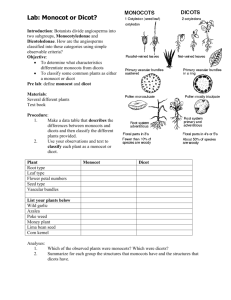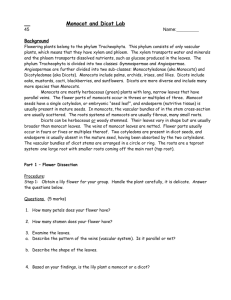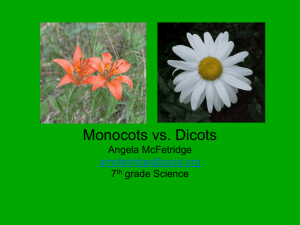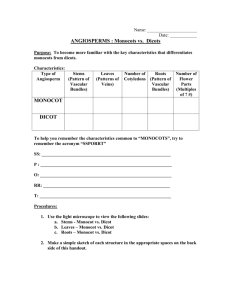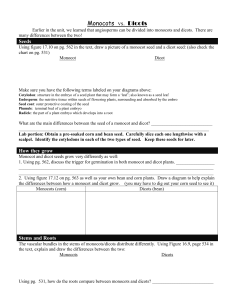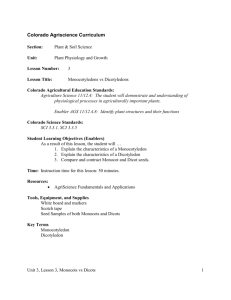Monocot and Dicot Lab
advertisement
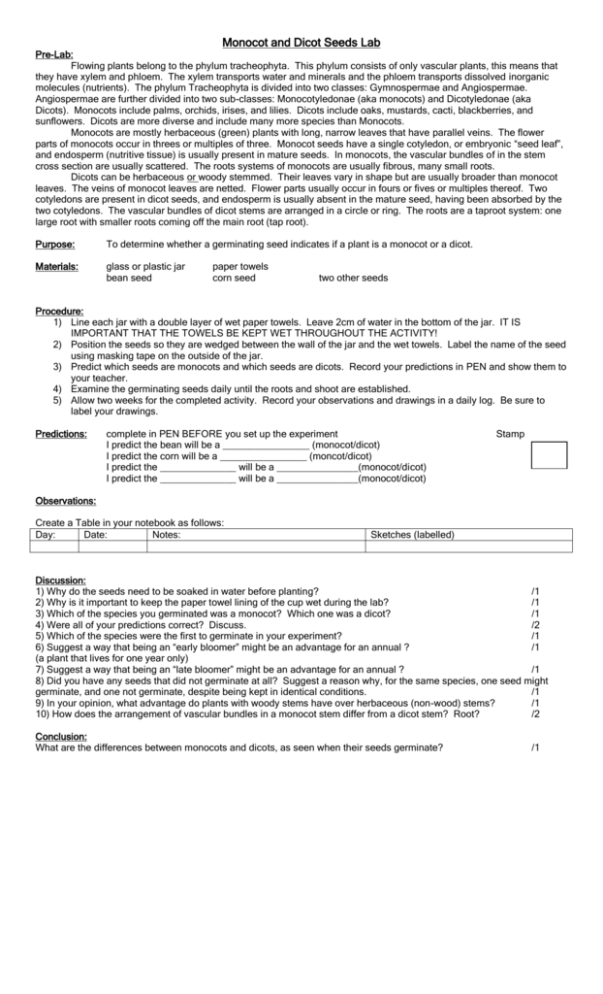
Monocot and Dicot Seeds Lab Pre-Lab: Flowing plants belong to the phylum tracheophyta. This phylum consists of only vascular plants, this means that they have xylem and phloem. The xylem transports water and minerals and the phloem transports dissolved inorganic molecules (nutrients). The phylum Tracheophyta is divided into two classes: Gymnospermae and Angiospermae. Angiospermae are further divided into two sub-classes: Monocotyledonae (aka monocots) and Dicotyledonae (aka Dicots). Monocots include palms, orchids, irises, and lilies. Dicots include oaks, mustards, cacti, blackberries, and sunflowers. Dicots are more diverse and include many more species than Monocots. Monocots are mostly herbaceous (green) plants with long, narrow leaves that have parallel veins. The flower parts of monocots occur in threes or multiples of three. Monocot seeds have a single cotyledon, or embryonic “seed leaf”, and endosperm (nutritive tissue) is usually present in mature seeds. In monocots, the vascular bundles of in the stem cross section are usually scattered. The roots systems of monocots are usually fibrous, many small roots. Dicots can be herbaceous or woody stemmed. Their leaves vary in shape but are usually broader than monocot leaves. The veins of monocot leaves are netted. Flower parts usually occur in fours or fives or multiples thereof. Two cotyledons are present in dicot seeds, and endosperm is usually absent in the mature seed, having been absorbed by the two cotyledons. The vascular bundles of dicot stems are arranged in a circle or ring. The roots are a taproot system: one large root with smaller roots coming off the main root (tap root). Purpose: To determine whether a germinating seed indicates if a plant is a monocot or a dicot. Materials: glass or plastic jar bean seed paper towels corn seed two other seeds Procedure: 1) Line each jar with a double layer of wet paper towels. Leave 2cm of water in the bottom of the jar. IT IS IMPORTANT THAT THE TOWELS BE KEPT WET THROUGHOUT THE ACTIVITY! 2) Position the seeds so they are wedged between the wall of the jar and the wet towels. Label the name of the seed using masking tape on the outside of the jar. 3) Predict which seeds are monocots and which seeds are dicots. Record your predictions in PEN and show them to your teacher. 4) Examine the germinating seeds daily until the roots and shoot are established. 5) Allow two weeks for the completed activity. Record your observations and drawings in a daily log. Be sure to label your drawings. Predictions: complete in PEN BEFORE you set up the experiment I predict the bean will be a ________________ (monocot/dicot) I predict the corn will be a ________________ (moncot/dicot) I predict the ______________ will be a _______________(monocot/dicot) I predict the ______________ will be a _______________(monocot/dicot) Stamp Observations: Create a Table in your notebook as follows: Day: Date: Notes: Sketches (labelled) Discussion: 1) Why do the seeds need to be soaked in water before planting? /1 2) Why is it important to keep the paper towel lining of the cup wet during the lab? /1 3) Which of the species you germinated was a monocot? Which one was a dicot? /1 4) Were all of your predictions correct? Discuss. /2 5) Which of the species were the first to germinate in your experiment? /1 6) Suggest a way that being an “early bloomer” might be an advantage for an annual ? /1 (a plant that lives for one year only) 7) Suggest a way that being an “late bloomer” might be an advantage for an annual ? /1 8) Did you have any seeds that did not germinate at all? Suggest a reason why, for the same species, one seed might germinate, and one not germinate, despite being kept in identical conditions. /1 9) In your opinion, what advantage do plants with woody stems have over herbaceous (non-wood) stems? /1 10) How does the arrangement of vascular bundles in a monocot stem differ from a dicot stem? Root? /2 Conclusion: What are the differences between monocots and dicots, as seen when their seeds germinate? /1
